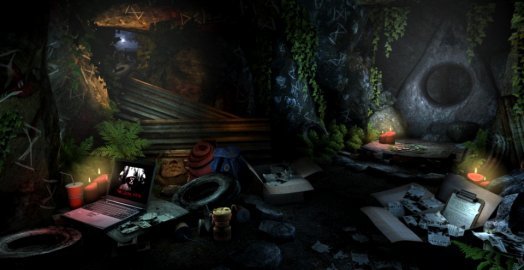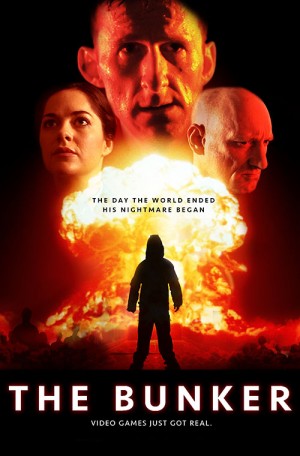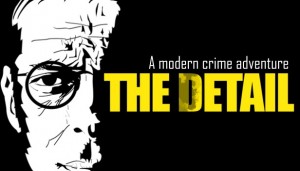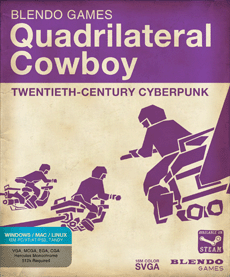Review for Barrow Hill: The Dark Path

Roughly ten years ago, a game was released by the name of Barrow Hill. Much like Nickelback and many other things from ten years ago, I had basically forgotten it existed until a few weeks ago when, seemingly out of nowhere, it was re-released via digital distribution, which is when I learned that the original game had a subtitle (Curse of the Ancient Circle), and more importantly, a sequel was being launched.
Barrow Hill: The Dark Path is a bit of a throwback, to the extent that if you told me it had actually been released a year after the original, instead of ten, and I had just somehow missed out on it, I’d be completely prepared to believe that. That’s not necessarily a bad thing. I thought the first one was a rather enjoyable slice of spooky point n’ click-ery (albeit undermined by some of its low-budget constraints), so I was rather looking forward to playing the sequel, even if it ended up being more of the same.
I don’t recall much about the story in the original game, other than you played a reporter (or something like that) visiting the eponymous location to investigate and ultimately put a stop to a supernatural menace unwittingly unleashed by an archaeological team and reducing the local populace to unsightly pools of ichor. (In retrospect, I guess I recall more than I thought I did.) The Dark Path takes place ten years after those events, when you’re once again called back to the scene to put a stop to another supernatural menace unwittingly unleashed, this time by a group of high school kids screwing around with dark magic, as kids are wont to do. The plot is tangentially linked to the first game, but the story is self-contained enough that you don’t need to rush out and play the original first (though don’t let that stop you, by any means). If you did play Barrow Hill, there are plenty of call-backs to the first game, but they’re mostly of the “oh yeah, I kinda remember that bit” variety.
While the story itself is fairly shallow, indie developer Matt Clark seems to have an affinity for the quaint little English countryside hellmouth he’s created, even though I’ve always just assumed that the entirety of the English countryside is generally a haunted hellscape. A lot of research and effort obviously went into crafting the setting (which is also documented in the developer’s blog), and much of the backstory and mythology are weaved into the game through ambient details like the radio DJ’s background chatter and the memorial cards left for victims from the previous game. This often isn’t directly relevant or even necessary for finishing the game, but it adds a lot of context, so even if the plot is a little thin, it makes the story feel a lot more substantial than it actually is.
Once upon a time, the horror-themed point-and-click adventure game was a rather reliable staple (Scratches, the Dark Fall series, Darkness Within, etc.), but once Amnesia became a phenomenon, the popular gameplay mechanic shifted from pointing-and-clicking to skulking-and-hiding and “psychological horror”, which for some reason still largely seems to rely on boogeymen jumping out at you from darkened corners. When I played the original Barrow Hill and its contemporaries, I remember the tension and the distinct feeling of the hairs on the back of my neck rebelling in dreaded anticipation, but since I recently forced myself to finally power through Amnesia and Outlast, I think I’ve been effectively de-sensitized to anything short of a demonic hand reaching out of my screen to throttle me. So, while there are a few moments in The Dark Path that might have set my former self on edge, they didn’t much register with me anymore.
But in fairness, with a traditional point-and-click horror game, although they’re not above an occasional cheap jump-scare (Barrow Hill had one that got me fully out of my chair at the time), the horror part was always kept at arm’s length just by the nature of the gameplay, which was focused on puzzles rather than monsters. The “horror” in these sorts of adventures is really about creating a suspenseful atmosphere while you go about your problem-solving rather than a feeling of imminent danger. The first game hit upon the right mix of moody graphic and sound design (along with the requisite spooky story) that created the appropriate air of detached menace, and in that regard The Dark Path succeeds just as well as its predecessor, even if the hairs on the back of my neck were quite relaxed this time around.
Refusing to stray from a proven formula, The Dark Path is a very traditional point-and-click adventure game. You’ll spend the bulk of your time clicking on points of interest, picking up inventory items and sorting out what to do with them, or solving an occasional arbitrary logic puzzle in order to perform a mundane task, such as switching on the power. The puzzles are mostly sensible, and they don’t really resort to the trappings of “adventure game logic”, aside from a few instances where the game demands that you find a very specific item to accomplish an objective, when you’ve got about three other things in your inventory what would likely work just as well. There’s also none of the in-game assistance that’s become relatively commonplace these days. No hotspot highlighter, no hints of any sorts. You’re on your own, but to the game’s credit, I rarely found myself frustrated or wandering about not knowing what to do next. In the few instances where I hit a wall, first figuratively and later literally, these were due to idiosyncrasies with the interface and the occasional bug, rather than an intentional design flaw.
In theory, the interface is about as simple as it gets. You have the context-sensitive cursor/pointer that changes to indicate you can interact with something, and an inventory panel. The inventory tends to get a bit cluttered towards the end of the game, since items stay there indefinitely even after you’re quite done with them, but the main problem I ran into is that the cursor seemed to be a little inconsistent in at least a few instances. On occasion, it would indicate that I couldn’t interact with something, but if I defiantly clicked on it anyway, I found that, in fact, I could.
More annoying, though, was when I was supposed to tear off a section of a document I was examining. Clicking on the document would pick it up and provide a close-up view to interact with. However, in the close-up view, the cursor doesn’t indicate you can do anything else with it, and clicking anywhere on the document other than the one specific intended spot will cause you to set it back down again, so naturally I assumed it was just window-dressing and moved on. Eventually, when I became completely stuck, I had to consult the Steam discussion group to figure out what I had missed. Although, as if to make up for this, on another occasion an item I needed (but hadn’t found yet) randomly appeared in my inventory.
The original Barrow Hill was a fine-looking game (though not the best among its peers), which is a good thing, because The Dark Path seems to have been literally poured from the same mould. Which is to say that if I saw a screenshot of each game side-by-side, I wouldn’t be able to tell the difference if I hadn’t already played both. This doesn’t make the graphics bad, but they’re obviously a product of their time, which is most apparent in that they appear to be rendered at a fixed resolution of 1024x768. If you’re reading between the lines, that means that yes, a game released in 2016 is using a native aspect ratio of 4:3. In fairness, once they’re scaled up and stretched out to the dimensions of the typical modern monitor, they’re perfectly serviceable, but much like me, they’re starting to show their greys a bit more than I’d like.
The game uses a first-person slideshow-style presentation but I hesitate to use the term slideshow, because it implies staring at a static picture, which isn’t a fair assessment. By current standards, the graphics are definitely on the less-sophisticated side, but even so, the prerendered scenes are lushly, bordering on lovingly, detailed, be it the radio station/trailer overflowing with fast food remnants and conspiracy-themed newspaper clippings tacked to the wall or the Celtic ruin bursting at the gills with a mix of pagan graffiti, foliage, used tires, discarded pamphlets and other miscellaneous junk those meddling kids left lying about. Most of the scenes have some type of ambient animations, which are fairly simple (think leaves falling or a fire burning) but add enough life that they maintain a decent suspension of disbelief.
If anything kills the mood, it’s the odd appearance of NPCs. Most of the time, your “interaction” with other characters is via FMV clips (usually Blair Witch-style videos of them whining about evil spirits chasing them) or cell phone conversations, but in a few instances you have to deal with them in person. Unfortunately, the characters tend a bit too much towards the creepy mannequin look, and even if the background graphics generally fall short of photorealistic territory, the models still look out of place, and obviously clash even more with the FMV. I assume that it’s pretty damned hard to create a realistic-looking model of a human being, but that’s probably why most games of its ilk usually just choose to superimpose live-action characters onto the prerendered backgrounds (which may not have always been much better, but at least it was more consistent).
The voices, on the other hand, range from quite decent to a bit goofy, averaging out around the level of high school drama club. Thankfully, the most prevalent character you’ll hear is the best of the lot. There’s not a ton of voice-overs, though. The majority of the time you’ll be left to your own devices, with nothing but the sounds of your surroundings and a bit of background music. Thankfully, these are pretty spot-on. Other than when you come across a couple of radios in the game, the background music is often present but subtle to the point that I specifically stopped to listen for it a few times. That’s not a knock against it, but rather it blends into the scene so well that it enhances the atmosphere without becoming a distraction, which is exactly what background music should do.
Similarly, the ambient noises do precisely what they should (think crickets chirping, doors opening and closing, the random rustling and creaking noises you hear in the woods). I can’t say that they’re really any better or worse than background sounds I’ve heard in other games, but they add just the right amount of detail to draw you into the scene, with the exception of one particular audio bug which caused the sound of a babbling brook to follow me around for the next half hour, which was simultaneously soothing and slightly annoying, but more importantly, made me need to get up to use the bathroom every five minutes.
My Steam counter is always screwed up, since I spend a lot of time mucking about with a game for review purposes, but I’d estimate an honest play time of about five hours, give or take. At that, it’s a solid appetizer of an adventure game with a few quirks of a bygone era. Even if the popular tenor of horror-themed adventure games has shifted, there’s certainly room for a more traditional adventure with a chilly atmosphere that doesn’t make me actually soil myself.
As I said at the first, if Barrow Hill: The Dark Path gave me nothing other than more of the same as the first game, I would have been completely content with that. And that’s basically what I got: nothing more, nothing less. It’s a bit like discovering an episode of your favorite television show you had somehow missed way back when.
WHERE CAN I DOWNLOAD Barrow Hill: The Dark Path
Barrow Hill: The Dark Path is available at:
- GOG -80%
- HumbleBundle
- Amazon




























